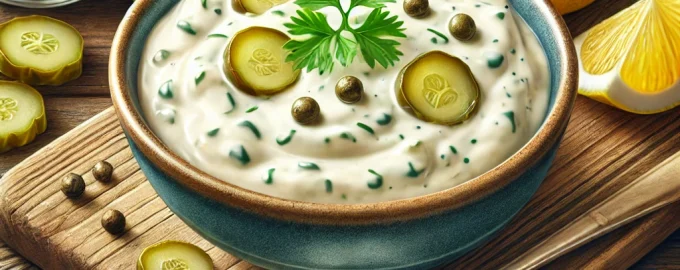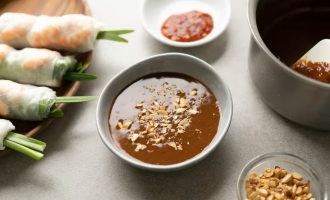- The Rich History of Tartar Sauce
- Preparation Time
- Equipment Needed
- Nutritional Information (per 2-tablespoon serving)
- Step-by-Step Instructions for How to Make Tartar Sauce with Pickles
- Step 1: Prepare the Pickles and Herbs
- Step 2: Prepare the Onion and Capers
- Step 3: Combine the Base Ingredients
- Step 4: Add the Flavoring Elements
- Step 5: Season the Tartar Sauce
- Step 6: Combine Thoroughly
- Step 7: Taste and Adjust
- Step 8: Chill Before Serving
- Variations and Recommendations for Homemade Tartar Sauce
- Classic Variations
- Regional Variations
- Dietary Adaptations
- Flavor Enhancements
- Best Fish to Serve with Homemade Tartar Sauce
- Fish and Chips — The classic pairing, where the creamy, tangy sauce cuts through the richness of battered and fried fish perfectly
- Fried Seafood — Shrimp, calamari, oysters, and scallops all benefit from a side of homemade tartar sauce
- Fish Cakes and Croquettes — The sauce adds moisture and flavor to these often dense preparations
- Grilled White Fish — Cod, halibut, tilapia, and sea bass are complemented by the bright flavors of tartar sauce
- Fish Sandwiches — A spread of tartar sauce elevates any fish sandwich, from po’ boys to fish filet sandwiches
- Smoked Fish — The creamy sauce provides a wonderful contrast to the intense flavors of smoked trout or whitefish
- Storage and Shelf Life
- Expert Tips for Perfect Simple Tartar Sauce
- Why Homemade Tartar Sauce Outshines Store-Bought
Are you wondering how to make tartar sauce at home that rivals your favorite restaurant’s version? This simple tartar sauce recipe creates the perfect accompaniment for fish and seafood dishes. With just a few basic ingredients including dill and pickles, you’ll learn how to make tartar sauce that’s creamy, tangy, and far superior to store-bought versions.
The Rich History of Tartar Sauce
Tartar sauce (sometimes spelled «tartare sauce») has a fascinating culinary history that stretches back centuries. Despite its name suggesting a connection to the Tartars—nomadic peoples from Central Asia—the sauce is actually French in origin.
The earliest versions of tartar sauce emerged in French cuisine during the mid-19th century. It was developed as a variation of remoulade sauce, which itself was derived from mayonnaise. The name «tartare» became associated with this sauce because it was traditionally served alongside «steak tartare,» a dish of raw minced beef named after the Tartar people.
French chefs created tartar sauce to complement seafood dishes, particularly fried fish. The creamy, tangy sauce provided a perfect counterbalance to rich, crispy fried seafood. The basic formula—mayonnaise enhanced with chopped pickles, herbs, and acidic elements—proved to be a winning combination.
By the early 20th century, tartar sauce had spread throughout Europe and North America, becoming especially popular in coastal regions where seafood was a dietary staple. As it gained international popularity, regional variations developed, with different cultures incorporating local ingredients while maintaining the sauce’s characteristic creamy-tangy profile.
In the United States, tartar sauce became firmly established as the quintessential accompaniment to fish and chips during the post-World War II era. American versions typically emphasized pickle relish and onions, creating a slightly sweeter profile than traditional French recipes.
Today, homemade tartar sauce with dill and pickles remains one of the world’s most beloved condiments for fish and seafood, available commercially but best when made fresh at home according to simple, time-tested recipes.
Preparation Time
- Prep time: 10 minutes
- Chilling time: 30 minutes (recommended)
- Total time: 40 minutes
- Yields: 1 1/4 cups (approximately 10 servings)
Equipment Needed
- Cutting board
- Sharp knife
- Measuring spoons and cups
- Mixing bowl
- Rubber spatula or mixing spoon
- Fine grater (for optional garlic or lemon zest)
- Storage container with tight-fitting lid
Nutritional Information (per 2-tablespoon serving)
NutrientAmountCalories 140
Protein 0.2g
Total Fat 15g
Saturated Fat 2.3g
Carbohydrates 1g
Dietary Fiber0.1g
Sugars 0.5g
Sodium 310mg
Cholesterol 10mg
Step-by-Step Instructions for How to Make Tartar Sauce with Pickles
Step 1: Prepare the Pickles and Herbs
Begin by finely chopping the dill pickles until they’re about the size of small peas. You want the pieces small enough to distribute evenly throughout the sauce but large enough to provide texture. Next, finely chop the fresh dill, removing any thick stems. The dill is crucial for making an authentic homemade tartar sauce with dill, providing a fresh, aromatic quality.
Step 2: Prepare the Onion and Capers
Mince the white onion very finely—this ensures you get the flavor without overwhelming chunks. Drain the capers and roughly chop them if they’re large, or leave them whole if they’re small. Capers add a distinctive briny flavor that enhances the classic tartar sauce profile.
Step 3: Combine the Base Ingredients
In a medium mixing bowl, combine the mayonnaise, lemon juice, and Dijon mustard. These ingredients form the creamy, tangy base of your simple tartar sauce. Whisk them together until completely smooth and well incorporated.
Step 4: Add the Flavoring Elements
Add the chopped dill pickles, minced onion, capers, and fresh dill to the mayonnaise mixture. The pickles provide tanginess essential for a proper tartar sauce for fish, while the onions add subtle sharpness, and the fresh herbs bring brightness.
Step 5: Season the Tartar Sauce
Add the salt, freshly ground black pepper, and Worcestershire sauce to the mixture. These seasonings add depth and balance to the sauce. The Worcestershire sauce provides a subtle umami quality that enhances the overall flavor profile.
Step 6: Combine Thoroughly
Using a rubber spatula or spoon, gently fold all ingredients together until evenly distributed throughout the sauce. Be thorough but avoid overmixing, which can break down the texture of the ingredients and make the sauce too runny.
Step 7: Taste and Adjust
Sample your homemade tartar sauce and adjust the seasonings according to your preference. You might want to add more lemon juice for acidity, another pinch of salt, or extra dill for more herbaceous flavor. Remember that the flavors will develop as the sauce rests.
Step 8: Chill Before Serving
Transfer the finished tartar sauce to an airtight container and refrigerate for at least 30 minutes before serving. This resting time allows the flavors to blend together and develop fully, resulting in a more harmonious sauce that’s perfect for serving with fish. The sauce will keep in the refrigerator for up to one week.
Variations and Recommendations for Homemade Tartar Sauce
Classic Variations
Extra Tangy Tartar Sauce For those who prefer a more pronounced tang, increase the lemon juice to 2 tablespoons and add 1 teaspoon of white wine vinegar. This variation cuts through rich fried fish particularly well.
Creamy Dill Tartar Sauce Double the fresh dill to 4 tablespoons and add 2 tablespoons of sour cream for an extra creamy, herb-forward sauce that pairs beautifully with salmon.
Pickle Lover’s Tartar Sauce For those wondering specifically how to make tartar sauce with pickles as the star, increase the chopped pickles to 1/2 cup and add 1 tablespoon of pickle brine. Use a mixture of dill and sweet pickles for a complex flavor profile.
Regional Variations
Southern-Style Tartar Sauce Add 1 tablespoon of sweet pickle relish and a dash of hot sauce for a Southern twist that complements catfish and hush puppies.
New England Tartar Sauce Incorporate 1/2 teaspoon of Old Bay seasoning and substitute finely chopped green olives for capers. This variation is perfect with fried clams or a classic New England fish fry.
Mediterranean Tartar Sauce Add 1 tablespoon of minced fresh parsley, 1 clove of minced garlic, and 1 teaspoon of capers. Replace half the mayonnaise with Greek yogurt for a Mediterranean-inspired sauce that pairs well with grilled fish.
Dietary Adaptations
Vegan Tartar Sauce Substitute the mayonnaise with vegan mayonnaise (made from plant oils and aquafaba). All other ingredients remain the same, creating a completely plant-based condiment that still delivers the classic tartar sauce flavor.
Low-Fat Version Replace half the mayonnaise with plain Greek yogurt to reduce the fat content while maintaining creaminess. The yogurt adds a pleasant tanginess but will make the sauce slightly less rich.
Keto-Friendly Tartar Sauce Use full-fat mayonnaise and add 1 tablespoon of olive oil to increase the healthy fat content. Ensure your pickles don’t contain added sugars to keep the carbohydrate count low.
Flavor Enhancements
Herb-Forward Tartar Sauce In addition to the dill, add 1 tablespoon each of finely chopped parsley, chives, and tarragon for a vibrant, herb-centric variation that complements delicate fish like sole or flounder.
Garlic Lover’s Tartar Sauce Add 1-2 cloves of finely minced or grated garlic for an aromatic twist. The garlic adds depth but should be used judiciously to avoid overpowering the other flavors.
Spicy Tartar Sauce Incorporate 1 teaspoon of prepared horseradish and 1/4 teaspoon of cayenne pepper for a sauce with extra kick. This variation stands up well to stronger-flavored fish like mackerel or bluefish.
Best Fish to Serve with Homemade Tartar Sauce
Tartar sauce is traditionally served with:
Fish and Chips — The classic pairing, where the creamy, tangy sauce cuts through the richness of battered and fried fish perfectly
Fried Seafood — Shrimp, calamari, oysters, and scallops all benefit from a side of homemade tartar sauce
Fish Cakes and Croquettes — The sauce adds moisture and flavor to these often dense preparations
Grilled White Fish — Cod, halibut, tilapia, and sea bass are complemented by the bright flavors of tartar sauce
Fish Sandwiches — A spread of tartar sauce elevates any fish sandwich, from po’ boys to fish filet sandwiches
Smoked Fish — The creamy sauce provides a wonderful contrast to the intense flavors of smoked trout or whitefish
Storage and Shelf Life
For the best experience with your homemade tartar sauce with dill:
- Refrigeration: Store tartar sauce in an airtight container in the refrigerator for up to one week.
- Freshness Indicators: If the sauce begins to separate or develops an off odor, it’s time to discard it.
- Do Not Freeze: Mayonnaise-based sauces like tartar sauce do not freeze well, as they tend to separate upon thawing.
- Serving Temperature: Remove the sauce from the refrigerator about 10-15 minutes before serving to take the chill off and allow the flavors to fully bloom.
- Revitalization: If the sauce thickens too much during storage, whisk in a few drops of lemon juice or water to restore the desired consistency.
Expert Tips for Perfect Simple Tartar Sauce
- Use Quality Mayonnaise: The foundation of any good tartar sauce is quality mayonnaise—either homemade or a premium store-bought variety.
- Fresh Herbs Matter: While dried dill can be substituted in a pinch (use 2 teaspoons instead of 2 tablespoons), fresh dill provides a brighter, more aromatic quality to the sauce.
- Pickle Selection: For the best flavor in your tartar sauce with pickles, use dill pickles rather than sweet or bread-and-butter varieties unless specifically creating a sweeter variation.
- Texture Control: For a smoother sauce, process the pickles, capers, and onions in a food processor before adding to the mayonnaise. For more texture, hand-chop these ingredients.
- Flavor Development: Tartar sauce improves with time as the flavors meld. Making it a day ahead results in a more harmonious blend of tastes when served with fish.
- Consistent Sizing: Chop all solid ingredients to approximately the same size for a consistent texture and even distribution of flavors throughout the sauce.
- Acid Balance: The right amount of acidity from lemon juice is crucial—it should brighten the sauce without making it sour. Start with less and add more to taste.
- Temperature Matters: Never serve tartar sauce straight from the refrigerator. Allowing it to warm slightly enhances the flavors and improves the texture when served with hot fish dishes.
Why Homemade Tartar Sauce Outshines Store-Bought
When you know how to make tartar sauce at home, you’ll never want to return to commercial versions. Homemade tartar sauce offers several advantages:
- Fresher Flavor: Without preservatives and stabilizers, homemade sauce has a brighter, cleaner taste.
- Customizable: You can adjust ingredients to suit your preferences or complement specific dishes.
- Better Texture: Commercial sauces often have a uniform, processed consistency, while homemade versions provide pleasant textural contrast.
- Healthier Options: You control the quality of ingredients and can make adaptations for dietary needs.
- Cost-Effective: Making tartar sauce at home is significantly less expensive than premium store-bought versions.
- No Artificial Ingredients: Homemade sauce avoids the additives, artificial flavors, and extra sugars often found in commercial products.
Learning how to make simple tartar sauce is a culinary skill that pays dividends whenever you serve seafood. This versatile condiment enhances everything from elegant fish dinners to casual fried seafood baskets, and once you’ve mastered the basic recipe, you can experiment with variations to suit your taste preferences and complement specific dishes.
Whether you’re making fish and chips for a family dinner, grilling salmon for a special occasion, or simply want to elevate your fish sandwich, this homemade tartar sauce with dill and pickles will become your go-to recipe. The perfect balance of creamy, tangy, and herbal flavors makes it the ideal accompaniment to any seafood dish.







